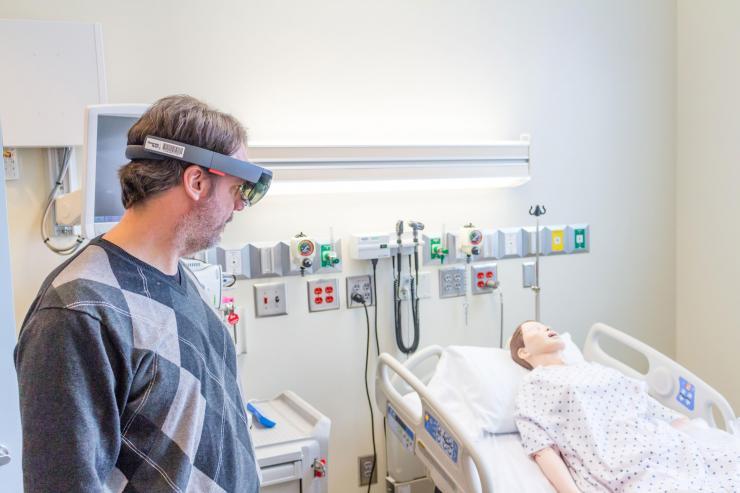The Future of Job Training
Jul 12, 2019 — Atlanta, GA

Scott Robertson, research scientist and associate director of the Interactive Media Technology Center
In August 2014, Emory University Hospital received national and international attention when it became the first hospital in the United States to treat a patient with Ebola virus disease. Dr. Kent Brantly, a medical missionary, contracted the disease in Liberia, a focal point for the worst Ebola outbreak in history.
After nearly two weeks in the hospital, Brantly recovered. Then, over the next two months, Emory treated three more Ebola survivors—another missionary, a doctor volunteering with the World Health Organization, and a nurse who became infected while caring for a patient with the Ebola virus.
Josia Mamora remembers that time vividly. He had recently relocated to Atlanta from Southern California and joined Emory’s Serious Communicable Disease Unit (SCDU) as a surgical ICU nurse. “I was privileged to take care of all four of our Ebola patients here at Emory,” he recalled. “It’s not like anything I’ve done before. It’s a lot different and a lot harder.”
It takes specialized training to care for highly infectious patients; Mamora leads this training every quarter at Emory. Hospital staff learns how to put on and remove PPE, or personal protective equipment, which they wear to minimize exposure to the virus. “Some of the skills that you build up—even basic skills like starting an IV—can get hard if you’re wearing a PPE,” said Mamora.
They also have to be extremely careful not to spread the virus. It’s common for Ebola patients to expel bodily fluids, which carry the virus. Mamora trains staff how to properly clean up fluid spills while continuing to monitor patients.
He currently uses a checklist-based system for training. In a conference room, he and other instructors demonstrate step-by-step, proper PPE procedures and how to clean up a simulated spill. According to Mamora, the training lacks realism. “It’s hard to impress upon new team members what it’s like to take care of these patients—the limitations in mobility with the [PPE] suit, the claustrophobia that you might experience.”
Augmented Reality Training
The SCDU team is now working with Georgia Tech’s Interactive Media Technology Center (IMTC) to create an augmented reality (AR) version of the training. Each trainee will have a first-person roleplaying experience where they practice the spill cleanup protocol rather than watching an instructor demonstrate it. IMTC research scientists used techniques from virtual reality video games to develop the training program. “It’s a more immersive, situated style of experience, including a rich audio environment that intentionally creates stress and distractions for the trainee so that it’s more realistic,” said Scott Robertson, research scientist and associate director of IMTC.
Robertson, and IMTC research scientists Jiten Chhabra, Maribeth Gandy Coleman, Laura Levy, Jeff Wilson, and Clint Zeagler are all working on the project. They interviewed Mamora and other nurses to get an idea of what to include in the training, which uses Microsoft’s HoloLens, a see-through AR head-mounted display (HMD).
During a training session, trainees will see virtual, AR elements realistically situated in the room around them, including a virtual spill, a patient in the hospital bed, and a patient care nurse. At critical points during the protocol, trainees will watch instructional videos and complete manual tasks like mimicking a spill cleanup. During a testing phase, they’ll have to recall each step of the protocol, all while listening to simulated sounds of a patient in distress.
IMTC is currently writing scripts, creating AR graphics and environmental audio, and filming instructional videos with Emory staff who will act as a patient and a nurse.
Besides being a training tool, Robertson says the AR program can help to answer research questions. “One problem with these kinds of AR and VR (virtual reality) training systems is they're often difficult for the end user to configure. It might not be intuitive for someone who’s never used one of these systems.”
Robertson will conduct a series of user studies to test different AR/VR configuration techniques. Do users prefer to learn traditional tapping and grasping hand gestures associated with AR/VR? Or do they prefer fiducials?—printed 2D barcodes that they can place on most surfaces to indicate where to overlay virtual objects. “The idea is to make these training systems easy for the end user who’s not an AR/VR or 3D expert to configure and modify on their own.”
Alyson Powell
Marketing Communications Manager
Institute for People and Technology




